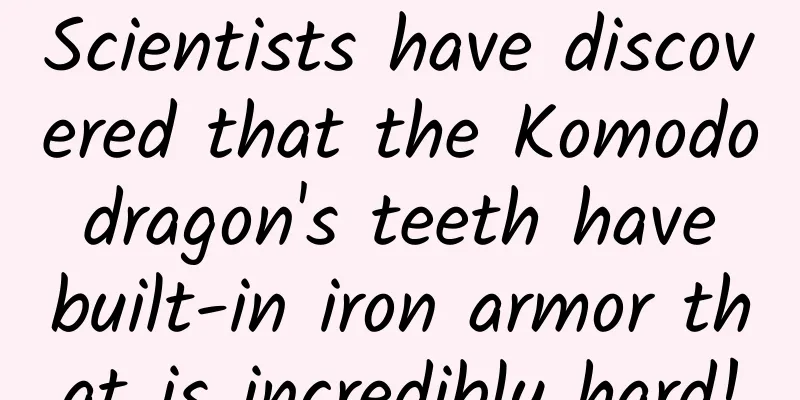Scientists have discovered that the Komodo dragon's teeth have built-in iron armor that is incredibly hard!

|
Produced by: Science Popularization China Author: Su Chengyu (popular science creator) Producer: China Science Expo Editor's note: In order to decode the latest mysteries of life science, the China Science Popularization Frontier Science Project has launched a series of articles called "New Knowledge of Life" to interpret life phenomena and reveal biological mysteries from a unique perspective. Let us delve into the world of life and explore infinite possibilities. Dragon teeth symbolize strength, protection, tenacity and mystery. In Greek mythology, Jason planted dragon teeth in the ground, and these dragon teeth turned into armed warriors; in fantasy novels, dragon teeth are used to make powerful magic weapons; in games, dragon teeth are used as materials for making powerful potions and magic items... It exists not only in the world of fantasy, but also in the real world. There is an anti-tank obstacle called Dragon's Tooth, which is a solid concrete structure used to block the attack of enemy tanks and armored vehicles. Dragon's Tooth, an anti-tank obstacle (Image source: Wikipedia) It is hard to say whether the teeth of other dragons are hard or not, after all, neither Eastern dragons (loong) nor Western dragons (dinosaurs are another matter) can be found in the real world. But there is a kind of "dragon" called Komodo dragon, which has been scientifically proven to have really hard teeth, because there is something "unusual" in its teeth. Komodo dragon (Image source: britannica) The giant lizard Komodo Dragon lives on Komodo Island in Indonesia. It is professionally known as the Komodo Dragon (Varanus komodoensis). It is the largest lizard on earth (male Komodo Dragons can be up to 3 meters long) and is famous for its huge size and deadly hunting skills. Its name has a long history. In 1912, the first Dutch expedition landed on this small island in Indonesia and brought back several "monsters" that were shot and named them Komodo Dragons. Komodo dragon skull (Image source: Wikipedia) Previous studies have shown that the Komodo dragon is venomous, and MRI scans of its skull have shown the presence of two venom glands in the lower jaw. However, little is known about its fangs. Aaron LeBlanc and his research team collected samples of Komodo dragon teeth from various natural history museums and zoos. These samples included bone specimens and teeth preserved in liquid. Scientists found that these teeth not only have serrated edges, but are also covered with a unique orange coating. Komodo dragon teeth, with serrations on the edges (Image source: Reference 1) This orange color is evident not only on the functional teeth but also on the replacement teeth, suggesting that the orange color is not a result of staining from eating. Orange coating (Image source: Reference 1) Functional teeth are teeth that are currently in use and perform actual functions. Replacement teeth are spare teeth that have not yet replaced functional teeth. For Komodo dragons, their new teeth usually begin to develop at the roots or sides of old teeth. As the new teeth mature, they push the old teeth out and eventually replace them. This process ensures that the Komodo dragon always has a fully functional set of teeth. Even the teeth have an orange coating (Image source: Reference 1) Next, the team used scanning electron microscopy (SEM) and energy dispersive spectroscopy (EDS) to conduct a detailed analysis of the tooth samples. They fixed the samples with resin and processed them under a vacuum environment. The samples were cut into thin slices for easy microscopic observation. In the SEM images, they clearly saw a bright coating on the surface of the teeth, which was an iron-rich coating with a thickness of about 1-2 microns. The thickness of the orange coating on the top layer of the crown under an electron microscope (Image source: Reference 1) To more precisely determine the composition of the tooth coating, the team used synchrotron X-ray microfluorescence spectroscopy (S-µXRF) and microdiffraction (S-µXRD). These techniques helped them confirm that the iron in the tooth coating was mainly in the form of hexahydrated iron oxide, which has also been found in the tooth coating of some rodents, such as the orange front teeth of tree-gnawing beavers. Beaver's large orange teeth (Photo source: McGill) Finally, to measure the hardness of these iron coatings, the scientists performed nanoindentation tests, measuring the hardness and elastic modulus of different parts of the teeth. In the nanoindentation test, the average hardness of the orange coating area was measured at 6.8 ± 0.3 GPa (Gigapascals), and the elastic modulus was measured at 110 ± 5 GPa. The average hardness of the enamel area without coating was measured at 6.0 ± 0.2 GPa, and the elastic modulus was measured at 100 ± 4 GPa. The results show that the presence of the orange metal coating does enhance the hardness and rigidity of the teeth, giving the Komodo dragon an advantage in hunting and tearing prey. Taking humans as an example, according to previous studies, the average hardness of human enamel is 4.5±0.5GPa , and the average elastic modulus is 100±10GPa . It can be seen that with the metal coating, it is indeed much stronger, at least in terms of hardness. Why can iron hydroxide coating enhance the hardness of teeth? According to the previous SEM and EDS analysis, the iron hydroxide in the coating is evenly distributed and tightly bonded to the enamel. This shows that when the iron hydroxide is deposited on the tooth surface, a strong interface bond is formed between these particles and the enamel. This interface bond enhances the adhesion of the coating to the tooth matrix through chemical bonds and physical intercalation, thereby improving the overall mechanical strength. Do other lizards have orange iron coatings on their teeth? Scientists have investigated the teeth of several species of monitor lizards (Varanus) and lizards (Heloderma), including extinct ancient monitor lizards. The figure below is a phylogenetic tree showing the evolutionary relationships between different monitor lizard species, with photos of the teeth of each monitor lizard and lizard. Red branches represent species with obvious and persistent tooth marginal pigments; black branches represent species with no obvious pigments; blue branches represent species with occasional or inconsistent pigmentation in their teeth; orange branches represent species with unknown pigmentation levels due to fossilization. (Image source: Reference 1) From this we can see that the teeth of lizards are quite different, but they generally have a serrated structure. Aaron Loeb thought about this before he did the experiment. He got the fallen teeth of several different crocodiles from the zoo and the fossil teeth of crocodiles from the Late Cretaceous period from Dinosaur Provincial Park in Alberta, Canada. Analysis of crocodile teeth (Image source: Reference 1) The results for crocodile teeth were not exactly the same as for Komodo dragons. In common, crocodile tooth samples also showed an iron-rich signature. However, the coating was not evenly distributed on the tooth surface and was not as thick as that of Komodo dragons. Further LA-ICP-MS analysis revealed increased concentrations of iron and calcium in the dentin of crocodile teeth, but no significant increase in iron concentration was observed in the outer enamel. In the fossil crocodile tooth samples (q, r in the above figure), the calcium and iron signals in the dentin are significantly enhanced, but no significant iron coating is seen in the enamel. This may be because the fossilization process obscures these features. It is hard to say. In general, although they are all large reptiles and are all fierce guys, the iron-rich coating has significant differences in structure and chemical composition. What about the dinosaurs? Unexpectedly, scientists also got the teeth of Tyrannosaurus and Dromaeosaurus! After observing the microstructure of their teeth, they found that there was no significant iron deposition on the serrated edges of Tyrannosaurus teeth. The iron was mainly concentrated in the dentin area inside the teeth, but the signal was not very obvious. In addition, the enamel of Tyrannosaurus was wavy, which may prevent crack propagation through complex microcrack paths, thereby enhancing the durability of the teeth. The teeth of Tyrannosaurus and Dromaeosaurus show obvious serrations (Image source: Reference 1) No significant iron signal was detected on the serrated edges or inside of the teeth of Dromaeosaurus. Moreover, the enamel of Dromaeosaurus teeth is relatively simple, mostly parallel crystallite enamel, which has a simpler structure than the wavy enamel of Tyrannosaurus teeth. Neither Tyrannosaurus nor Dromaeosaurus teeth show significant iron deposition, in stark contrast to the iron coating in Komodo dragon teeth. It could be that the fossilization process obscured the signal, or that these dinosaurs did not have this adaptation in their teeth. Although no iron coating was found, according to tests, the enamel and dentin of Tyrannosaurus are twice as hard as the corresponding areas of Komodo dragons and Mississippi alligators. This may be the effect of fossilization, so it is hard to say how hard the teeth of living dinosaurs are. But they are definitely hard, at least harder than human teeth, after all, the microscopic structure is there. Dragon teeth are really hard! They are worthy of being the top predator! References: 1.LeBlanc ARH, Morrell AP, Sirovica S, et al. Iron-coated Komodo dragon teeth and the complex dental enamel of carnivorous reptiles[J]. Nature Ecology & Evolution, 2024: 1-12. |
>>: Why do I want to cry when I have a quarrel? I feel so much empathy...
Recommend
bmob personal lost property application_app development template
Source code introduction The source code is very ...
How do Guangzhou merchants make profits through mini programs? How can individuals make profits by developing WeChat mini-programs?
WeChat mini programs are business opportunities i...
ZUK Z1 review: Has the goal of “Android version of iPhone” been achieved?
I'm sorry, I don't know the specific mean...
Brand marketing strategy: random event marketing gameplay
This kind of random event marketing method has ne...
Bailong Essay Douban In-depth Drainage Course, Drain 200+ Quasi-fine Powders per Day Worth 599 Yuan (Completed)
The course comes from Bailong Essays Douban’s in-...
The dilemma of operators: WeChat in front and Apple behind
[[134314]] Recently, there has been a lot of disc...
Wandering in the rivers of the Ali Plateau
The beauty of harmony and balance outlined by the...
Self-driving trams to hit the streets of Moscow, to be tested on closed tracks over the next two months
According to foreign media New Atlas, a Russian u...
520 marketing strategy! Here it comes
Although 520 is an ordinary holiday, its pronuncia...
It's a big hit! Hundreds of thousands of people watch this video every day at the subway station here...
In the past two days, Fuzhou residents Have you n...
Being deprived of physical strength, mental strength and even breathing, all because of this "traditional delicacy"
"...Okay, smile, smile at Pava, smile at the...
A new beginning, BYD Auto announced a new logo on January 1
On January 1, BYD Auto officially released its ne...
Du Ziteng's Douyin vocal music course complete version 12 lessons
What I want to introduce to you today is Du Ziten...
Douyin STOM full-link advertising solution
Today, I will also share with you my experience o...
How did the toothbrush "transform" from a tree branch into the current smart black technology?
A good set of teeth affects not only your appeara...









